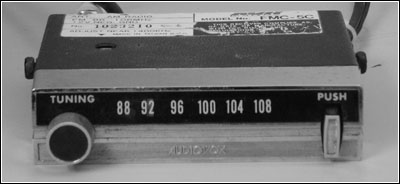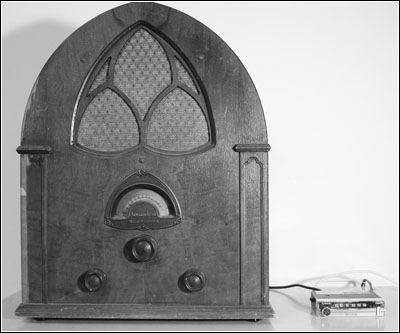Of Old Radios And Related Items--Published Monthly
Listen to FM on Your Antique Radio
BY AL SMITH
Web Edition
Al Smith describes a practical way to adapt your old radios to receive FM stations. (Editor)
Want to add FM reception to your old AM radio? Shown in Figure 1 is an FM converter that can do just that. These converters, used to add monaural FM reception to AM automobile radios, were sold in the 1960s under various brand names and models. The one pictured here is an Audiovox FMC-5C.
The audio output of the FM tuner in these devices is used to modulate an internal AM oscillator. When this signal is fed to an AM-only auto radio, it enables the radio to receive FM broadcasts. Now that virtually every car has FM, there is no longer any need for these devices in cars; but they can find good use in the homes of radio collectors.
Receiving FM stations on an antique or classic AM radio requires only a converter, a 12-volt/500mA wall-type power supply, such as a Radio Shack part number 273-1773, and an FM antenna. An automotive-type antenna is not required. Any standard 75-ohm FM antenna may be used.
The Motorola-type antenna input socket on the converter can be connected to a standard F-type TV/FM cable connector by using two adapters. The Radio Shack 278-160 is a female BNC to Motorola adapter and the part number 278-277 is a BNC male to female Type F adapter. Using part number 278-160 alone will allow connection to a BNC male connector.
Figure 1. The Audiovox FM converter used with AM car radios to provide monaural FM reception.Figure 2 shows the FM converter in use with an Atwater Kent Model 84 cathedral. The only connections to the Atwater Kent is to the antenna and ground terminals.
This approach is an easy way to expand your source of radio programming.
(Al Smith, 25 Stonehedge Rd., Lincoln, MA 01773)
Al Smith hasn't outgrown his interest in consumer electronics which began at age 10. During high school, he arranged with a local college store to offer radio repair services. By the time he went off to college to become an electrical engineer, he had repaired over 400 radios. After working for Sprague Electric Company, he went on to get a Ph.D in Applied Physics and a career in magnetic recording. His collection focuses on radios of the 1930s-1960s era and on professional test equipment.
Figure 2. The author's setup consists of an Atwater Kent Model 84 and an Audiovox FMC-5C converter.
| [Free Sample] [Books, etc., For Sale] [Subscribe to A.R.C./Renew] [Classified Ads] [Auction Prices] [Event Calendar] [Links] [Home] [Issue Archives] [Book Reviews] [Subscription Information] [A.R.C. FAQ] URL = http://www.antiqueradio.com/Aug06_Smith_FM.html Copyright © 1996-2006 by John V. Terrey - For personal use only. Last revised: July 27, 2006. For Customer Assistance please contact ARC@antiqueradio.com or call (866) 371-0512 toll free
Antique Radio Classified |

